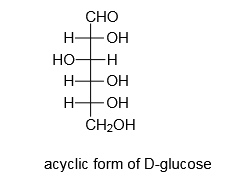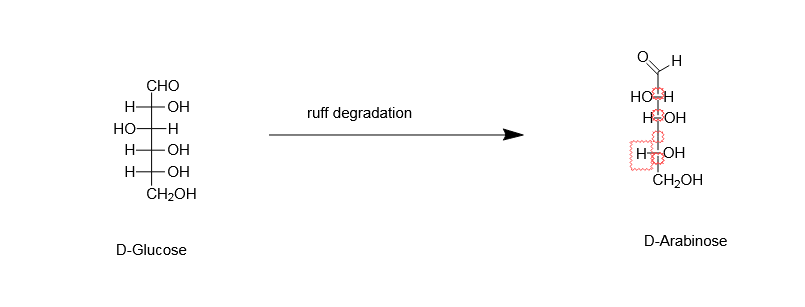
The ruff degradation used to reduce the carbon chain in an –
(A) Alcohol
(B) Alkene
(C) Ketose
(D) Aldose
Answer
127.8k+ views
Hint: Ruff degradation is a synthetic method to shorten the carbon-chain. It was first studied by Otto Ruff on glucose molecules.
Complete solution:
If we will add an aldehydic group to an acyclic form of monosaccharide, the resulting monosaccharide will be an aldose.

Ruff degradation will shorten the above chain by removing one carbon atom.

The overall conversion mechanism can be stated as follows-
The terminal aldehydic group is made to undergo selective oxidation, by using bromine water, and then it is converted to gluconate ion. In the next step, $Fe(OAc)3$ with 30% of $H2O2$ is added. This will result in the formation of $CO2$ along with a stereo selective compound from COO- ion. And in the downside, $ - CH2OH$will get converted to $ - CHO$ group. This conversion is achieved by the reduction of iron $Fe$ from its +3 state to +2 state. In this way, we get the product, D-Arabinose.

So, the correct option is D.
Note:
Ruff degradation has been named after its discoverer, Otto Ruff.
Alcohol dehydrogenase (ADH) is the enzyme that can break down alcohol into acetaldehyde. This enzyme can be found in the liver cells.
Arabinose acts as an inhibitor of enzyme Sucrase. This enzyme is present in the small intestine and helps to break down sucrose into fructose and glucose. Because of this ability, it is commercialized as a sweetener.
Arabinose is also used as a reversible switch for protein expression in E.coli
Complete solution:
If we will add an aldehydic group to an acyclic form of monosaccharide, the resulting monosaccharide will be an aldose.

Ruff degradation will shorten the above chain by removing one carbon atom.

The overall conversion mechanism can be stated as follows-
The terminal aldehydic group is made to undergo selective oxidation, by using bromine water, and then it is converted to gluconate ion. In the next step, $Fe(OAc)3$ with 30% of $H2O2$ is added. This will result in the formation of $CO2$ along with a stereo selective compound from COO- ion. And in the downside, $ - CH2OH$will get converted to $ - CHO$ group. This conversion is achieved by the reduction of iron $Fe$ from its +3 state to +2 state. In this way, we get the product, D-Arabinose.

So, the correct option is D.
Note:
Ruff degradation has been named after its discoverer, Otto Ruff.
Alcohol dehydrogenase (ADH) is the enzyme that can break down alcohol into acetaldehyde. This enzyme can be found in the liver cells.
Arabinose acts as an inhibitor of enzyme Sucrase. This enzyme is present in the small intestine and helps to break down sucrose into fructose and glucose. Because of this ability, it is commercialized as a sweetener.
Arabinose is also used as a reversible switch for protein expression in E.coli
Recently Updated Pages
Difference Between Vapor and Gas: JEE Main 2024

Area of an Octagon Formula - Explanation, and FAQs

Difference Between Solute and Solvent: JEE Main 2024

Absolute Pressure Formula - Explanation, and FAQs

Carbon Dioxide Formula - Definition, Uses and FAQs

Charle's Law Formula - Definition, Derivation and Solved Examples

Trending doubts
JEE Main 2025 Session 2: Application Form (Out), Exam Dates (Released), Eligibility & More

JEE Main Exam Marking Scheme: Detailed Breakdown of Marks and Negative Marking

JEE Main 2025: Conversion of Galvanometer Into Ammeter And Voltmeter in Physics

JEE Mains 2025 Correction Window Date (Out) – Check Procedure and Fees Here!

Learn About Angle Of Deviation In Prism: JEE Main Physics 2025

JEE Main 2025: Derivation of Equation of Trajectory in Physics

Other Pages
JEE Advanced Marks vs Ranks 2025: Understanding Category-wise Qualifying Marks and Previous Year Cut-offs

NCERT Solutions for Class 12 Chemistry Chapter 6 Haloalkanes and Haloarenes

NCERT Solutions for Class 12 Chemistry Chapter 1 Solutions

NCERT Solutions for Class 12 Chemistry Chapter 2 Electrochemistry

NCERT Solutions for Class 12 Chemistry Chapter 9 Amines

NCERT Solutions for Class 12 Chemistry Chapter 7 Alcohol Phenol and Ether




